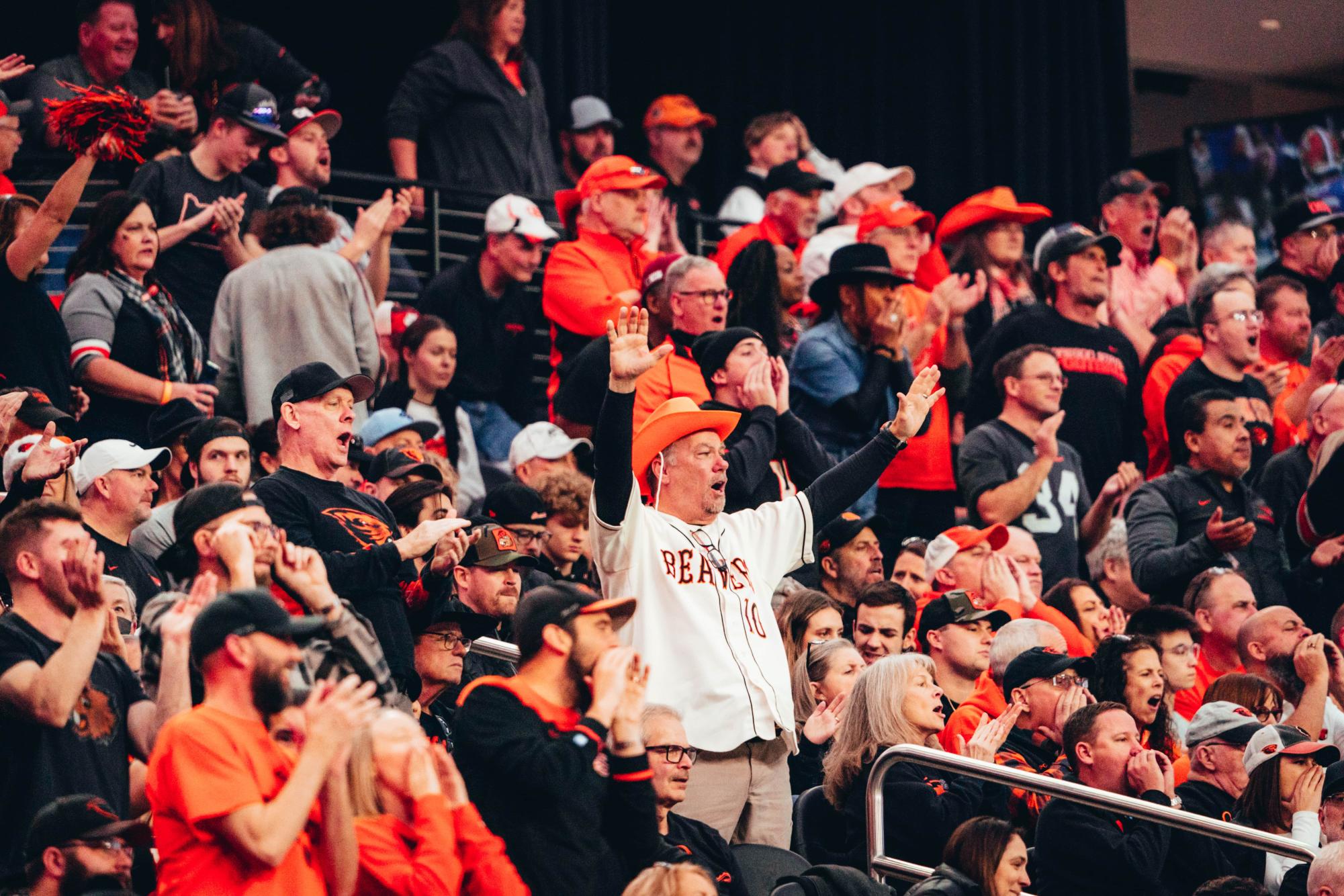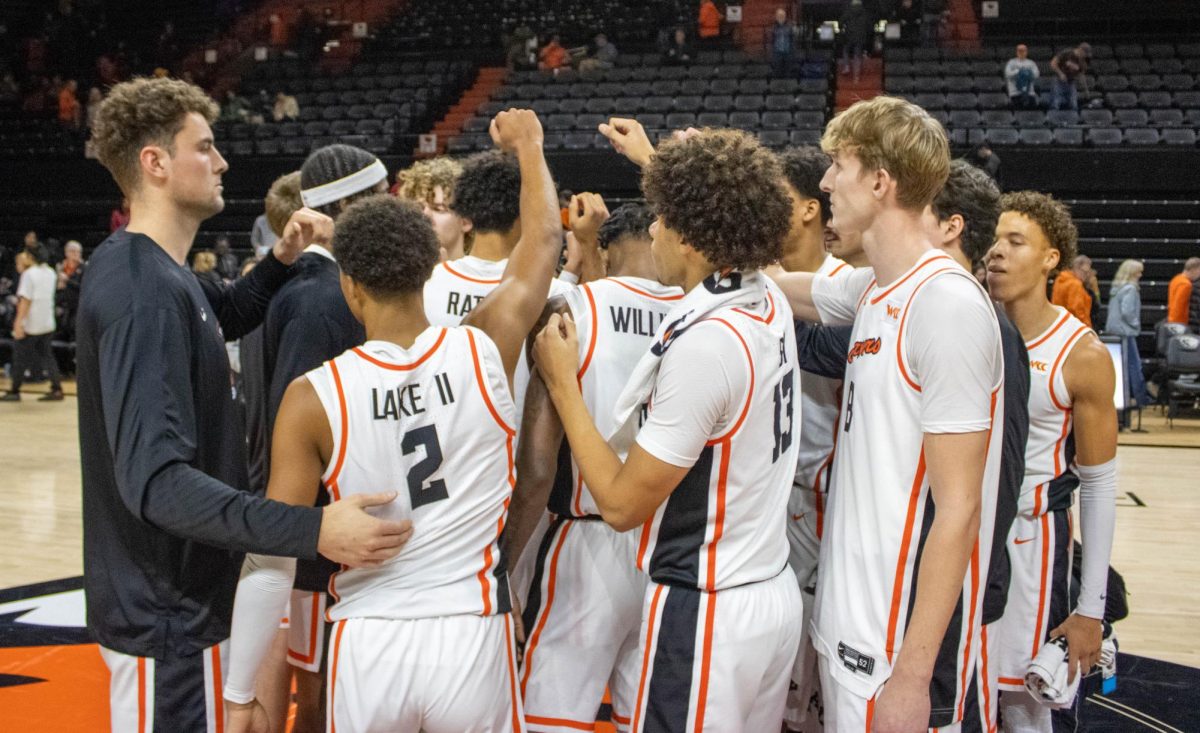As he proudly wears his Beaver gear on the 8,252th day, Marvin “Beaverman” Yonamine is one of many fans who share utter disappointment in the collapse of the PAC-12 conference.
In the past week, University of Oregon, University of Washington, University of Utah, University of Arizona and Arizona State University joined University of Southern California, University of California Los Angeles and University of Colorado Boulder in leaving the PAC-12 to join conferences like Big-10 and Big-12.
“If you didn’t see the PAC-12 failing…if you didn’t see it coming, you weren’t paying attention,” said Nick Lilja, former sports editor and columnist for the Daily Barometer.
Lilja said he could see the end of the conference ten years ago, and felt the conference collapse was due to the PAC-12 not jumping to at least 16 teams.
“There are a lot of people who are angry, because it’s a big shock that a powerful conference could be killed like this. But rather than being angry, like a lot of people, I’m extremely, extremely disappointed,” Beaverman said.
Like Beaverman, other fans have expressed frustration at the PAC-12 news, especially when it comes to regional rivalry established over 63 years ago.
“In the former PAC-12, you have decades of built-in history cheering against certain programs,” said former Daily Barometer Sports Chief Brady Akins. “Without those nine built-in PAC-12 conference games you start to lose a lot of the passion that’s special.”
Senator Chandler Donahey of the Associated Students of OSU shared sadness in that the entire PAC-12 conference fell apart so rapidly.
“I completely understand the desires of schools to explore new opportunities. But I do find it rather sad to see so much conference history wiped away in a day,” Donahey said.
Lilja added that with closer proximity, fans are more likely to have at least one connection to the other school OSU was playing against.
“It was an easy way to have a good rivalry with not only other teams, but like people you knew. Like, you could laugh and be like, ‘Ducks lost again,’ with the guy that sat behind you, or a client that you met with once a week or whatever,” Lilja said.
In terms of student -athletes, Beaverman stressed that athletics are continuously rising above academics for athletes, especially for universities who have now left the PAC-12 conference.
“We have to emphasize to everyone in the NCAA and college athletics, number one, academics is first and number two, athletics is extracurricular,” Beaverman said.
“I have a lot of concern for the future of student athletes, and what these changes might mean for them,” Donahey said.
Now, these student-athletes who have been forced to leave the PAC-12 must fly across the country frequently, Beaverman, Lilja and Akins all agreed–academics will be left behind.
“I feel bad for the student athletes. They don’t even have a choice. They’re forced to go to New Jersey, they’re forced to go to Maryland, they’re forced to fly halfway across the country,” Lilja said.
According to Lilja, flying across the country every week while taking midterms and finals is a “difficult ask.”
“I think you’re chasing money at the expense of the student athletes…you’re going to fly them halfway across the country, every other week for a game? And expect them to pass a class,” Lilja said. “For the kids that are taking Monday, Wednesday, Friday classes and a Thursday lab? Well, guess what? You’re missing the lab on Thursday, you’re missing class on Friday.”
The realignment of the PAC-12 will mean OSU has to navigate finding their way to a different conference, meaning the PAC-12 will no longer be a “powerhouse conference,” according to Akins.
“It’s similar across all college sports in that you have a collection of conferences that are viewed as the powerhouse, prestigious conferences, all the others outside that collection are largely an afterthought to most people,” Akins said. “The PAC-12 was one of those conferences, and being a part of the PAC-12 meant OSU was in a pretty good spot compared to teams in less prestigious conferences.”
Akins said they believe OSU will lose revenue and national attention with the realignment of the PAC-12, meaning OSU’s fight will be more difficult when the goal means reaching high-level bowl games.
“We’ve seen similar stories for years now of teams outside the major conferences having to play at unsustainably high levels just to get invited to bowl games,” Akins said. “Whereas the PAC-12 and other major conferences get to send like half their teams to bowl games automatically.”
Fans such as Beaverman blame universities who left the PAC-12 on their desire for more wealth, and in the words of Beaverman, “greed.”
“The nuclear arms race in which these universities are convinced to tell you that, ‘oh, we need millions of dollars every year to win a national championship.’ But it’s not sustainable for 90% of the universities to have these huge athletic budgets,” Beaverman said.
Beaverman’s suggestion to level the playing field is to have a funding cap for all public and private universities, similar to how professional teams have salary caps.
“You have a salary cap, or the NCAA has to have a salary cap for athletic departments budgets,” Beaverman said. “I don’t care if it’s Louisiana State University Football, University of Georgia Football…you put a salary cap–or a cap on your athletic department–and every school cannot exceed this.”
As for this final year of the PAC-12 legacy, fans such as Akins shared thoughts about how important games will be when playing against those who have chosen to leave the PAC-12.
“Winning conference games is going to mean everything now. I think if you’re an Oregon State coach or athlete you have to be furious at every single team that’s leaving the PAC-12,” Akins said. “Deep down I think everyone associated with OSU athletics wants to go on a revenge tour and show all the teams that are leaving that they’re better than any competition they’ll face in any other conference.”
The Daily Barometer will continue to post updates on the realignment of the PAC-12.













































































































